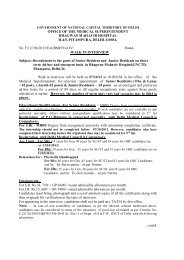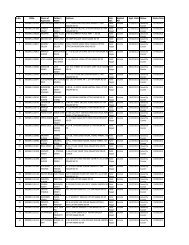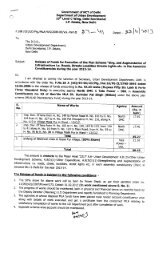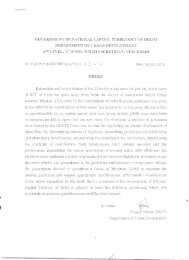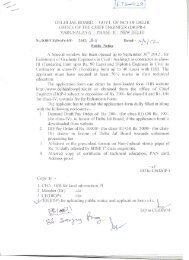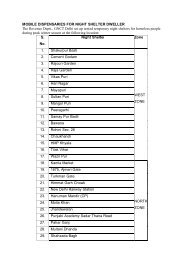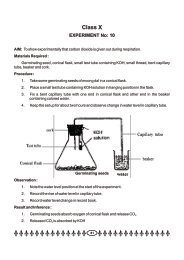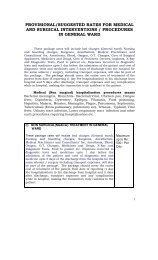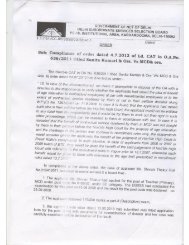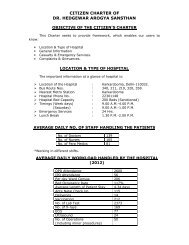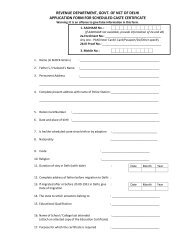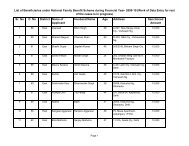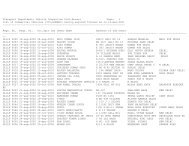1. ADUSA (VASAKA) Botanical Name Part used Medicinal ... - Delhi
1. ADUSA (VASAKA) Botanical Name Part used Medicinal ... - Delhi
1. ADUSA (VASAKA) Botanical Name Part used Medicinal ... - Delhi
Create successful ePaper yourself
Turn your PDF publications into a flip-book with our unique Google optimized e-Paper software.
<strong>1.</strong> <strong>ADUSA</strong> (<strong>VASAKA</strong>) <strong>Botanical</strong> <strong>Name</strong><br />
<strong>Part</strong> <strong>used</strong><br />
<strong>Medicinal</strong> Uses<br />
Adhatoda vasica<br />
Leaves, flowers and bark<br />
Used for treating bronchitis, asthma and dental<br />
ailments. It relieves cough and breathlessness. Its<br />
local use gives relief in pyorrhoea and in bleeding<br />
gums.<br />
2. AKARKARA <strong>Botanical</strong> <strong>Name</strong><br />
<strong>Part</strong> <strong>used</strong><br />
<strong>Medicinal</strong> Uses<br />
Anacylus pyrethrum DC.<br />
Roots<br />
Relieves toothache, cures chronic catarrh and is<br />
<strong>used</strong> as an aphrodisiac. Generally known to be a<br />
tonic to the nervous system and an aid in digestion.<br />
3. APARAJITA (BUTTERFLY PEA) <strong>Botanical</strong> <strong>Name</strong><br />
<strong>Part</strong> <strong>used</strong><br />
<strong>Medicinal</strong> Uses<br />
Clitoria ternatea<br />
Roots, leaves<br />
Memory enhancer, antidepressant and overall a<br />
sedative agent.
4. ARKAPARNI <strong>Botanical</strong> <strong>Name</strong><br />
<strong>Part</strong> <strong>used</strong><br />
<strong>Medicinal</strong> Uses<br />
Tylophora indica<br />
Roots and leaves<br />
Used for treating respiratory problems like asthma<br />
and in the treatment of certain allergies and<br />
rheumatism.<br />
5. ASHWAGANDHA (WINTER CHERRY/<br />
INDIAN GINSENG)<br />
<strong>Botanical</strong> <strong>Name</strong><br />
<strong>Part</strong> <strong>used</strong><br />
<strong>Medicinal</strong> Uses<br />
Withania somnifera<br />
Roots and Leaves<br />
Medicine for treatment of various diseases such as<br />
leprosy, nervous disorders and intestinal infections.<br />
A tonic for all kinds of weakness.<br />
It has been <strong>used</strong> in diseases such as rheumatism,<br />
depression, arthritis, low backache and impotency.<br />
6. AJWAIN <strong>Botanical</strong> <strong>Name</strong><br />
<strong>Part</strong> <strong>used</strong><br />
<strong>Medicinal</strong> Uses<br />
Carum copticum<br />
Leaves , Seeds<br />
Used as a culinary herb. It reduces flatulence ca<strong>used</strong><br />
by beans when it is cooked with beans. Seeds may<br />
be <strong>used</strong> as a substitute for cumin as well. It is also<br />
traditionally known for supporting the digestion.
7. BHUI AMLA <strong>Botanical</strong> name:<br />
<strong>Part</strong> <strong>used</strong>:<br />
<strong>Medicinal</strong> Uses:<br />
Phyllanthus amarus/niruri<br />
Whole Plant<br />
It is a common household remedy for the treatment<br />
of all liver problems including Jaundice.<br />
8. BHRINGRAJ (FALSE DAISY) <strong>Botanical</strong> <strong>Name</strong><br />
<strong>Part</strong> <strong>used</strong><br />
<strong>Medicinal</strong> Uses<br />
Eclipta prostrata/alba<br />
Whole plant<br />
Hair disorders, eye disorders, tuberculosis, mouth<br />
infections and chronic cold. Also <strong>used</strong> in the<br />
treatment of scorpion stings, loss of appetite and<br />
anaemia.<br />
9. BRAHMI (INDIAN PENNYWORT) <strong>Botanical</strong> <strong>Name</strong><br />
<strong>Part</strong> <strong>used</strong><br />
<strong>Medicinal</strong> Uses<br />
Bacopa monnieri<br />
Whole herb<br />
Antioxidant properties. It is a brain tonic, memory<br />
enhancer and facilitates learning. Also <strong>used</strong> for<br />
curing epilepsy and inflammations.
10. CHITRAK <strong>Botanical</strong> <strong>Name</strong><br />
<strong>Part</strong> <strong>used</strong><br />
<strong>Medicinal</strong> Uses<br />
Plumbago zeylanica<br />
Root, root bark, seeds<br />
Useful in inflammation, bronchitis, itching. The<br />
leaves are <strong>used</strong> for treating rheumatism and<br />
ringworm. The root helps in improving digestion.<br />
1<strong>1.</strong> CITRONELLA GRASS <strong>Botanical</strong> <strong>Name</strong><br />
<strong>Part</strong> <strong>used</strong><br />
<strong>Medicinal</strong> Uses<br />
Cymbopogon winterianus<br />
Leaves<br />
Citronella oil is <strong>used</strong> in perfumery and as an insect<br />
repellent.<br />
12. CORIANDER <strong>Botanical</strong> name:<br />
<strong>Part</strong> <strong>used</strong>:<br />
<strong>Medicinal</strong> Uses:<br />
Coriandrum sativum<br />
Leaves and seeds<br />
Against fever, digestive aid, diuretic and killer of<br />
intestinal worms.
13. GUGGUL <strong>Botanical</strong> name:<br />
<strong>Part</strong> <strong>used</strong>:<br />
<strong>Medicinal</strong> Uses:<br />
Commiphora wightii<br />
Gum Resin of Guggul is <strong>used</strong>.<br />
Provides relief from skin diseases, ulcers, obesity,<br />
epilepsy, and rheumatoid arthritis. It also lowers<br />
blood cholesterol.<br />
14. GURMAR <strong>Botanical</strong> name:<br />
<strong>Part</strong> <strong>used</strong>:<br />
<strong>Medicinal</strong> Uses:<br />
Gymnema sylvestre<br />
Roots and Leaves<br />
This is one of the main herbs <strong>used</strong> for healing<br />
diabetes mellitus.<br />
15. GILOE <strong>Botanical</strong> <strong>Name</strong><br />
<strong>Part</strong> <strong>used</strong><br />
<strong>Medicinal</strong> Uses<br />
Tinospora cordifolia<br />
Leaves and stem<br />
It is useful in rheumatism, gout, dyspepsia, urinary,<br />
diseases. It is a liver tonic. Its watery extract is<br />
known as Indian quinine.
16. GHRITKUMARI (ALOE VERA) <strong>Botanical</strong> <strong>Name</strong><br />
<strong>Part</strong> <strong>used</strong><br />
<strong>Medicinal</strong> Uses<br />
17. HALDI (TURMERIC) <strong>Botanical</strong> name:<br />
<strong>Part</strong> <strong>used</strong>:<br />
<strong>Medicinal</strong> Uses:<br />
Aloe vera<br />
Leaves (pulp)<br />
Possesses purgative action. Aloe gel is <strong>used</strong> in<br />
many cosmetic products. It is <strong>used</strong> in the cure of<br />
skin diseases, wounds, tooth-ache and acidity. It<br />
also helps in cough, piles, constipation, jaundice and<br />
gout.<br />
Curcuma Longa<br />
Rhizomes<br />
Blood purifier, antiseptic and anti-aging. It is <strong>used</strong><br />
for treatment of cold, insect stings, inflammation,<br />
liver affections and as a skin tonic.<br />
18. HARSHINGAR (NIGHT-FLOWERING<br />
JASMINE)<br />
<strong>Botanical</strong> name:<br />
<strong>Part</strong> <strong>used</strong>:<br />
<strong>Medicinal</strong> Uses:<br />
Nyctanthes arbortristis<br />
Flowers and leaves<br />
It is antibacterial, anti-inflammatory, anthelmintic,<br />
expectorant, bitter, tonic and a mild purgative. Used<br />
for treating constipation, arthritis, fever and<br />
restlessness.
19. HIBISCUS <strong>Botanical</strong> name:<br />
<strong>Part</strong> <strong>used</strong>:<br />
<strong>Medicinal</strong> Uses:<br />
Hibiscus rosa-sinensis<br />
Roots, leaves and flowers<br />
Diuretic, laxative, lowering blood pressure and<br />
curing cough. Also <strong>used</strong> for hair care (against loss<br />
and greying).<br />
20. INSULIN PLANT <strong>Botanical</strong> name:<br />
<strong>Part</strong> <strong>used</strong>:<br />
<strong>Medicinal</strong> Uses:<br />
Costus Igneus<br />
Leaves<br />
Used for treating diabetes. Other uses are in the<br />
treatment of rash, fever, bronchitis and intestinal<br />
worms.<br />
2<strong>1.</strong> ISABGOL <strong>Botanical</strong> name:<br />
<strong>Part</strong> <strong>used</strong>:<br />
<strong>Medicinal</strong> Uses:<br />
Plantago Ovata Husk<br />
Seeds<br />
It is diuretic, antitoxic, emollient and cooling. Used in<br />
inflammatory conditions of mucous membrane of<br />
gastro-intestinal and genito-urinary tracts. Very well<br />
known as a laxative.
22. KALMEGH (KIRAYAT) <strong>Botanical</strong> <strong>Name</strong><br />
<strong>Part</strong> <strong>used</strong><br />
<strong>Medicinal</strong> Uses<br />
Andrographis paniculata<br />
Whole Plant<br />
Immunosuppressive, blood purifier, anthelmintic,<br />
astringent. It is beneficial in treating fever, jaundice,<br />
cholera, malaria, anaemia, loss of appetite and<br />
dysentery.<br />
23. KADIPATTA (CURRY LEAVES) <strong>Botanical</strong> <strong>Name</strong><br />
<strong>Part</strong> <strong>used</strong><br />
<strong>Medicinal</strong> Uses<br />
Murraya koenigii<br />
Leaves<br />
Curry leaf promotes appetite and digestion. The<br />
decoction of the raw dried leaves is taken orally to<br />
cure dysentery.<br />
24. KALABANSA <strong>Botanical</strong> <strong>Name</strong><br />
<strong>Part</strong> <strong>used</strong><br />
<strong>Medicinal</strong> Uses<br />
Justicia gendarussa<br />
Leaves<br />
It has beneficial effects on respiratory disorders like<br />
cough, cold, bronchitis, throat infections, pulmonary<br />
infections and allergic disorders as well as bronchial<br />
asthma.
25. LAJWANTI <strong>Botanical</strong> <strong>Name</strong><br />
<strong>Part</strong> <strong>used</strong><br />
<strong>Medicinal</strong> Uses<br />
Mimosa Pudica<br />
Roots, leaves, flower heads<br />
Used for treating bleeding diarrhoea, cough, piles,<br />
inflammation and jaundice.<br />
26. LAVENDER <strong>Botanical</strong> <strong>Name</strong><br />
<strong>Part</strong> <strong>used</strong><br />
<strong>Medicinal</strong> Uses<br />
27. LEMON GRASS <strong>Botanical</strong> <strong>Name</strong><br />
<strong>Part</strong> <strong>used</strong><br />
<strong>Medicinal</strong> Uses<br />
Lavandula officinalis<br />
Leaves<br />
It is <strong>used</strong> as essential lavender oil which is antiinflammatory<br />
and anti-septic. In pillows, lavender<br />
seeds and flowers aid sleep and relaxation. It is also<br />
<strong>used</strong> in making perfumes.<br />
Cymbopogon citratus<br />
Aerial <strong>Part</strong>s<br />
Leaves are <strong>used</strong> in making Lemon Tea which is<br />
beneficial in cough and cold. Lemon oil is <strong>used</strong> as<br />
aromatic oil and as insect repellent.
28. MANDUKAPARNI <strong>Botanical</strong> <strong>Name</strong><br />
<strong>Part</strong> <strong>used</strong><br />
<strong>Medicinal</strong> Uses<br />
29. MULETHI (LICORICE) <strong>Botanical</strong> <strong>Name</strong><br />
<strong>Part</strong> <strong>used</strong><br />
<strong>Medicinal</strong> Uses<br />
Centella asiatica<br />
Whole plant<br />
Antibacterial, anti-inflammatory. Used in the<br />
treatment of leprosy and epilepsy. Famous for<br />
enhancing the receptive capacity of mind in<br />
improving the power of speech and poetic<br />
imagination.<br />
Glycyrrhiza glabra<br />
Roots<br />
Expectorant, laxative and diuretic. Improves<br />
digestion, reduces pain and strengthens the nervous<br />
system.<br />
30. MEHENDI (HENNA) <strong>Botanical</strong> <strong>Name</strong><br />
<strong>Part</strong> <strong>used</strong><br />
<strong>Medicinal</strong> Uses<br />
Lawsonia inermis<br />
Leaves, bark and seeds<br />
Leaves are effective in headache, itching and<br />
burning sensation as well as mental disorder. Used<br />
for cosmetic purposes like hair colouring and<br />
temporary Henna tattoos.
3<strong>1.</strong> METHI <strong>Botanical</strong> <strong>Name</strong><br />
<strong>Part</strong> <strong>used</strong><br />
<strong>Medicinal</strong> Uses<br />
Trigonella Foemum<br />
Leaves and stem<br />
Used to cure digestive disorders. It is anti-flatulent,<br />
mildly laxative and anti-inflammatory. It is very<br />
effective in post-delivery cases as it promotes<br />
lactation and controls body aches.<br />
32. MARJORAM <strong>Botanical</strong> <strong>Name</strong><br />
<strong>Part</strong> <strong>used</strong><br />
<strong>Medicinal</strong> Uses<br />
Origanum majorana<br />
Generally the whole herb, especially the leaves.<br />
Expectorant, sedative. Useful for respiratory and<br />
digestive disorders. Mostly <strong>used</strong> for flavouring food.<br />
33. NIRGUNDI <strong>Botanical</strong> <strong>Name</strong><br />
<strong>Part</strong> Used<br />
<strong>Medicinal</strong> Uses<br />
Vitex Negundo<br />
Roots, flowers, leaves, seeds<br />
Astringent and anthelmintic. Useful in treatment of<br />
inflammation, asthma and teething of children. Also<br />
<strong>used</strong> to relieve menopausal symptoms.
34. OREGANO <strong>Botanical</strong> <strong>Name</strong><br />
<strong>Part</strong> <strong>used</strong><br />
<strong>Medicinal</strong> Uses<br />
Origanum vulgare<br />
Seeds<br />
Anti-oxidant and antibiotic. Treats indigestion,<br />
bloating, flatulence, coughs, fever and urinary<br />
problems. Especially <strong>used</strong> in flavouring food.<br />
35. PARSLEY <strong>Botanical</strong> <strong>Name</strong><br />
<strong>Part</strong> <strong>used</strong><br />
<strong>Medicinal</strong> Uses<br />
Petroselinum crispum<br />
Leaves<br />
Diuretic, antitoxic, antiseptic, stimulating digestion.<br />
Used to treat bladder, kidney and prostrate<br />
problems. When crushed and rubbed on the skin,<br />
parsley can reduce itching of mosquito bites.<br />
36. PATCHOULI <strong>Botanical</strong> <strong>Name</strong><br />
<strong>Part</strong> <strong>used</strong><br />
<strong>Medicinal</strong> Uses<br />
Pogostemon cablin<br />
Leaves<br />
Oil extracted from leaves is antidepressant,<br />
antiseptic, astringent, diuretic and fungicide. Also<br />
<strong>used</strong> in perfumes and insect repellents.
37. PATHER CHUTT <strong>Botanical</strong> <strong>Name</strong><br />
<strong>Part</strong> <strong>used</strong><br />
<strong>Medicinal</strong> Uses<br />
Bryophyllum calycinum<br />
Leaf<br />
It is rich in alkaloids, triterpenes, glyucosides,<br />
flavonoids, steroids and lipids. Leaves prevent ulcer<br />
and treat acute inflammation.<br />
38. PEPPERMINT <strong>Botanical</strong> <strong>Name</strong><br />
<strong>Part</strong> <strong>used</strong><br />
<strong>Medicinal</strong> Uses<br />
Mentha piperita<br />
Leaves<br />
Fights against toxins in body and boosts mental<br />
powers. Peppermint tea is effective against irritable<br />
bowel syndrome. Leaves when rubbed on forehead,<br />
give relief from headache.<br />
39. PUDINA <strong>Botanical</strong> <strong>Name</strong><br />
<strong>Part</strong> <strong>used</strong><br />
<strong>Medicinal</strong> Uses<br />
Mentha arvensis<br />
Whole Plant<br />
Antibacterial, antifebrile, expectorant. Mint essential<br />
oil and menthol are extensively <strong>used</strong> as flavourings<br />
in breath fresheners, drinks, antiseptic mouth rinses,<br />
toothpaste, chewing gum, desserts and candies.
40. PUNARNAVA <strong>Botanical</strong> <strong>Name</strong><br />
<strong>Part</strong> <strong>used</strong><br />
<strong>Medicinal</strong> Uses<br />
Boerrhavia diffusa<br />
Whole herb, root<br />
Diuretic, antibacterial, anti-oxidant. Used for<br />
menstrual and kidney disorders, abdominal tumours<br />
and dyspepsia. It also vitalises the heart.<br />
4<strong>1.</strong> ROSEMARY<br />
<strong>Botanical</strong> name<br />
<strong>Part</strong> <strong>used</strong><br />
<strong>Medicinal</strong> uses<br />
Rosmarinus officinalis<br />
Leaves<br />
Used in cosmetic products and to flavour food. It is<br />
antiseptic, improves blood flow and has calming<br />
effects by working against fatigue, sadness and<br />
anxiety. It is also popular for improving memory.<br />
42. RATI <strong>Botanical</strong> <strong>Name</strong><br />
<strong>Part</strong> <strong>used</strong><br />
<strong>Medicinal</strong> uses<br />
Abrus precatorius<br />
Seeds, roots<br />
Purgative, tonic and aphrodisiac. The leaf juice can<br />
be <strong>used</strong> to reduce painful swellings.
43. SATAVAR <strong>Botanical</strong> <strong>Name</strong><br />
<strong>Part</strong> <strong>used</strong><br />
<strong>Medicinal</strong> Uses<br />
Asparagus racemosus<br />
Roots<br />
Improves physical stamina and increases body<br />
immunity.<br />
44. STEVIA (SUGARLEAF) <strong>Botanical</strong> <strong>Name</strong><br />
<strong>Part</strong> <strong>used</strong><br />
<strong>Medicinal</strong> Uses<br />
Stevia rebaudiana<br />
Leaves<br />
The processed leaves yield a natural sweetener<br />
which is a substitute for table sugar, safe for<br />
diabetics as it does not affect blood sugar levels.<br />
45. SADABAHAR (PERIWINKLE) <strong>Botanical</strong> <strong>Name</strong><br />
<strong>Part</strong> <strong>used</strong><br />
<strong>Medicinal</strong> Uses<br />
Catharanthus roseus<br />
Leaves and flowers<br />
Hypotensive, anti-spasmodic. Leaves are the source<br />
of valuable alkaloids which are <strong>used</strong> in the treatment<br />
of leukaemia, diabetes, malaria and Hodgkin’s<br />
disease.
46. SARPAGANDHA (SNAKEROOT) <strong>Botanical</strong> <strong>Name</strong><br />
<strong>Part</strong> <strong>used</strong><br />
<strong>Medicinal</strong> Uses<br />
Rauvolfia Serpentina<br />
Leaves, Fruits<br />
Used for treatment of high blood pressure, mental<br />
disorders, insomnia, snake bites and hypertension.<br />
47. SHANKHPUSHPI <strong>Botanical</strong> <strong>Name</strong><br />
<strong>Part</strong> <strong>used</strong><br />
<strong>Medicinal</strong> Uses<br />
Evolvulus alsinoides<br />
Whole plant<br />
Tonic and febrifuge as well as Vermifuge. Also <strong>used</strong><br />
to promote hair growth.<br />
48. THYME <strong>Botanical</strong> <strong>Name</strong><br />
<strong>Part</strong> <strong>used</strong><br />
<strong>Medicinal</strong> Uses<br />
Thymus vulgaris<br />
Leaves and flowering tops<br />
Thyme is <strong>used</strong> for cough and bronchitis as it<br />
produces expectoration and reduces bronchial<br />
Spasm. It also makes a good use in indigestion,<br />
gastritis, and diarrhoea. The essential oil is <strong>used</strong> in<br />
mouth washes and hand sanitizers.
49. TULSI (HOLY BASIL) <strong>Botanical</strong> <strong>Name</strong><br />
<strong>Part</strong> <strong>used</strong><br />
<strong>Medicinal</strong> Uses<br />
50. VACHA <strong>Botanical</strong> <strong>Name</strong><br />
<strong>Part</strong> <strong>used</strong><br />
<strong>Medicinal</strong> Uses<br />
Ocimum sanctum<br />
Leaves<br />
Treat cold, cough & dysentery. Tulsi is likely to prove<br />
prophylactic against the negative effects of<br />
environmental toxins, including cancer. The<br />
essential oil is <strong>used</strong> in cosmetics due to its<br />
antibacterial activity.<br />
Acorus calamus<br />
Rhizome or the root<br />
Sedative, laxative, diuretic. Vacha is <strong>used</strong> as a<br />
nervine tonic and an anti-stammering drug & potent<br />
psychopharmacological agent having a positive<br />
effect on the memory and the learning process.



